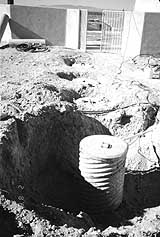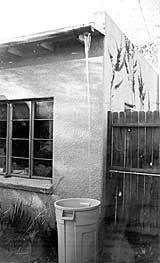
| ch. 3, pp. 31 - 33 |
And there are other questions: How is it determined that precipitation was in fact the result of weather modification? How is the amount of new water to be quantified for credit and distribution? On what basis is the new water induced by weather modification to be allocated among water users? How can those who pay for the weather modification be ensured that they will in fact receive their share of the new water? Environmental problems also may arise. For example, increased precipitation might mean increased weed growth, and a heavier snowpack could disrupt the winter food habitat of large mammals. Concern has also been expressed about the effects of introducing artificial ice-crystal nuclei (e.g. silver iodide, dry ice and liquid propane) into the atmosphere. Environmental studies are obviously needed to determine the effects of cloud seeding. Graywater reuse and water harvesting can be effective ways for individuals to decrease their use of groundwater and thus lower their water bill. Both strategies, however, probably do not contribute very much to the overall water supply picture in the basin. In areas connected to the central sewage system, use of graywater reduces the amount of effluent produced and consequently the amount available for reuse or recharge. Water harvesting also reduces the need to pump groundwater and may help relieve flooding problems. At Casa del Agua, a water conservation demonstration house that was supported by the University of Arizona, Tucson Water and ADWR, UA researchers tested and evaluated various water saving devices and strategies, including graywater use and water harvesting. Use of Graywater Graywater is water from the bath, shower, washing machine or bathroom or kitchen sinks in homes. Graywater can supply most, if not all the irrigation needs of a domestic dwelling landscaped with vegetation of a semiarid region. Along with its use in outside irrigation, graywater can be used in some situations for toilet flushing. Metro Water, a utility serving northwest Tucson, recently conducted a survey that found nine percent of its customers use some portion of their graywater. Graywater systems vary from simple low-cost systems to highly complex and costly units. The technology involved in such systems ranges from the sophisticated to the crude, from engineered systems with filters and pumps to a washing machine draining directly onto oleander bushes. A permit is technically required to install a graywater system although few people bother. Although ADEQ regulates graywater use in the state, the agency allows counties to issue permits. Any request that involves an exception to what is allowed in the regulations, however, must go directly to ADEQ for consideration. Some observers believe this splitting of regulatory authority for graywater use adds undue complicates the process of obtaining a permit. The main concern of regulations is that graywater use will result in water quality problems and pose a threat to public health. Regulations prohibit graywater systems from being connected to potable water systems and do not allow surface applications of graywater. Instead graywater must be released below the surface, as underground landscape irrigation, to prevent human contact with it. Many advocates claim the regulations are needlessly complex, and the expense is a deterrent to graywater use. Despite regulatory requirements estimates indicate that there are several thousand graywater systems in the metropolitan area, and virtually none are permitted. Some residents merely drain their washing machines to water their shrubs or trees. Some researchers question whether graywater really poses a significant health risk. If the health risks are not as high as some fear, graywater might gain more acceptance as a water source, and regulations could be eased.
With an ADWR TAMA Conservation Assistance Grant, the Water Conservation Alliance of Southern Arizona (Water CASA) is conducting a study to determine what health risks, if any, result from the low-tech methods of graywater use now occurring. Water CASA is in the process of analyzing several “wildcat graywater systems,” to accurately analyze and evaluate their water quality, soil chemistry and system design. The intent of the study is to raise public awareness, provide information not available elsewhere regarding graywater quality and its effect on soil, collect data on actual, feasible residential graywater system design and determine the potential graywater has to increase water use efficiency. Water Harvesting
Rainwater harvesting is collecting rainfall to meet water needs. A rainwater harvesting system concentrates and collects rain falling on house roofs and grounds for direct use and storage. Water is collected or harvested from concrete patios, driveways and other paved areas. Also harvested is the flow from the roof and from catchments such as gutters. Houses can be designed to maximize the amount of catchment area, thereby increasing rainwater harvesting possibilities. For example, at Casa del Agua, 600 square feet of additional catchment area was added to the porch and greenhouse roof to maximize runoff. This additional surface increased the amount of collected annual rainfall by more than 3,700 gallons. Downspouts are located about every 20 feet along the gutter, instead of the more common 40 feet. This ensured that heavy rains were not likely to overflow the gutter and instead would flow to catchments.
|


